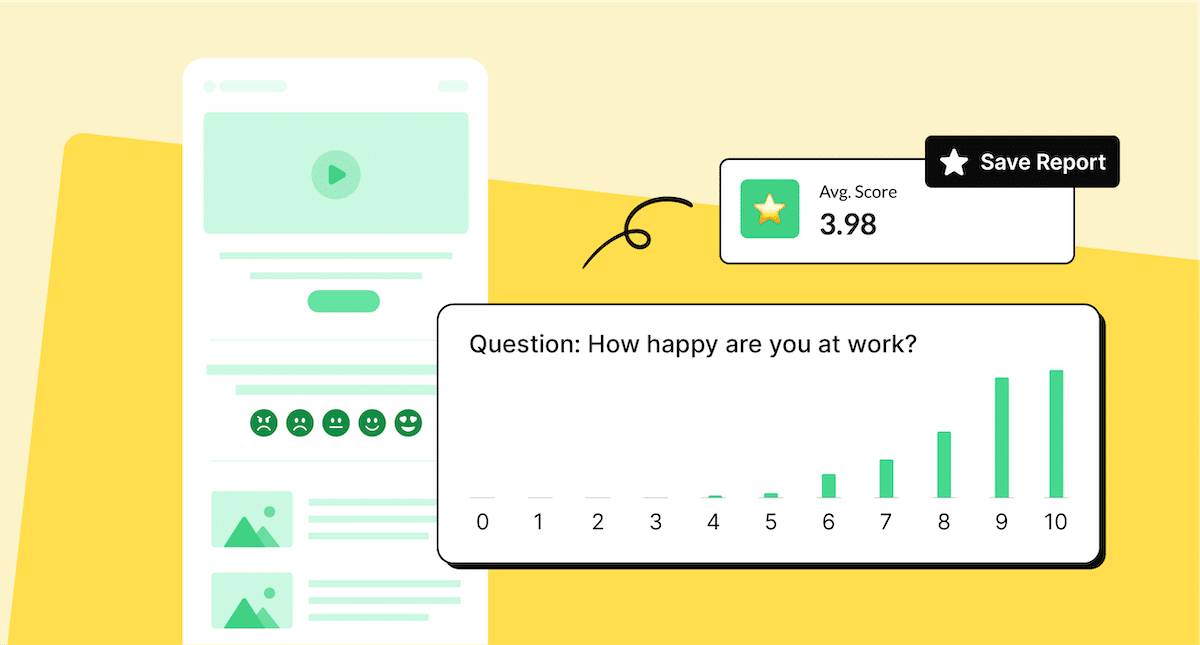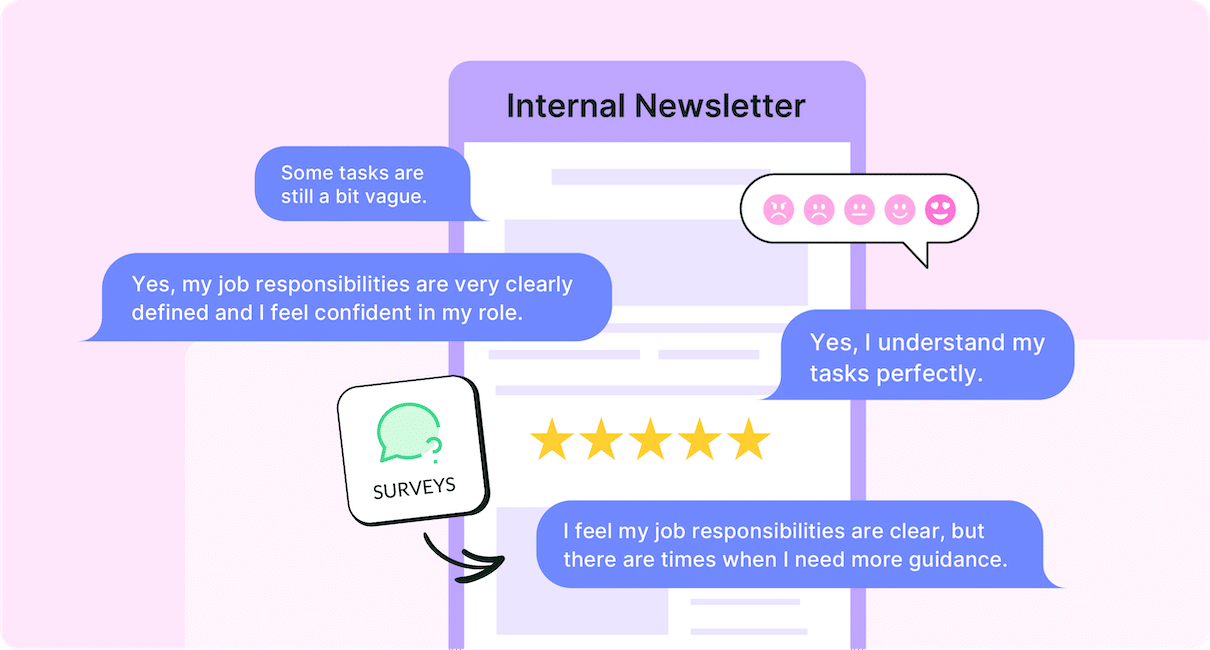Your employees have a unique point of view when it comes to operations and employee experience across your organization. To tap into their perspectives, you need to conduct regular employee opinion surveys and act on them strategically.
Learning what employees think about your organization is absolutely necessary for ensuring the wellbeing of your staff and your company at large.
Not to mention, showing that your organization genuinely cares about employee opinions is motivating and can help to boost employee engagement.
By implementing a strategic approach to gathering employee insights, via an employee opinion survey, you can implement informed change across your company. And we’ll show you how it’s done.
See how ContactMonkey’s survey features make it quick and easy to create, send, and track your employee email surveys.
Take a self-guided tour of ContactMonkey
See how our key features can streamline your internal communications.
Take product tour

What Is an Employee Opinion Survey?
An employee opinion survey is an evaluation for your entire company. You get an idea for your current standing among employees, measure employee satisfaction levels, and see how likely they are to recommend your company to others.
Employee opinion surveys are also an umbrella term to capture a range of surveys designed to gather employee insights. These include:
These surveys—all examples of asynchronous communications—help you be strategic about making positive change across your company and making more informed decisions. Your employee opinion surveys should target every area of the employee experience—from company culture, to compensation, and professional development.
It’s also important to include a mix of open-ended questions, scale rating questions, and yes / no questions to get more well-rounded employee insights.
Get better workplace engagement insights with these staff survey questions.
Benefits of an Employee Opinion Survey
Conducting an employee opinion survey has countless benefits. These types of surveys are able to assess employee satisfaction and engagement levels, while gauging opinions on company culture and leadership. To that end, employee opinion survey benefits stem from the actionable data you’re able to collect and inform things such as:
- The implementation of employee development programs
- How to strengthen company culture
- Improving relationships between employees and managers
- Creating better employee training initiatives and employee handbooks
- Improving customer service
- Interest in attending external events like internal comms events
Moreover, by conducting an employee opinion survey, you’re first and foremost showing your staff that you sincerely value their input. This instills confidence in your teams, boosts employee morale, and drives employee engagement by providing motivation.
Create and send employee surveys for feedback
Engage staff with pulse surveys, eNPS surveys, reusable surveys, custom polls, and more. Ready to send modern emails?
Explore survey features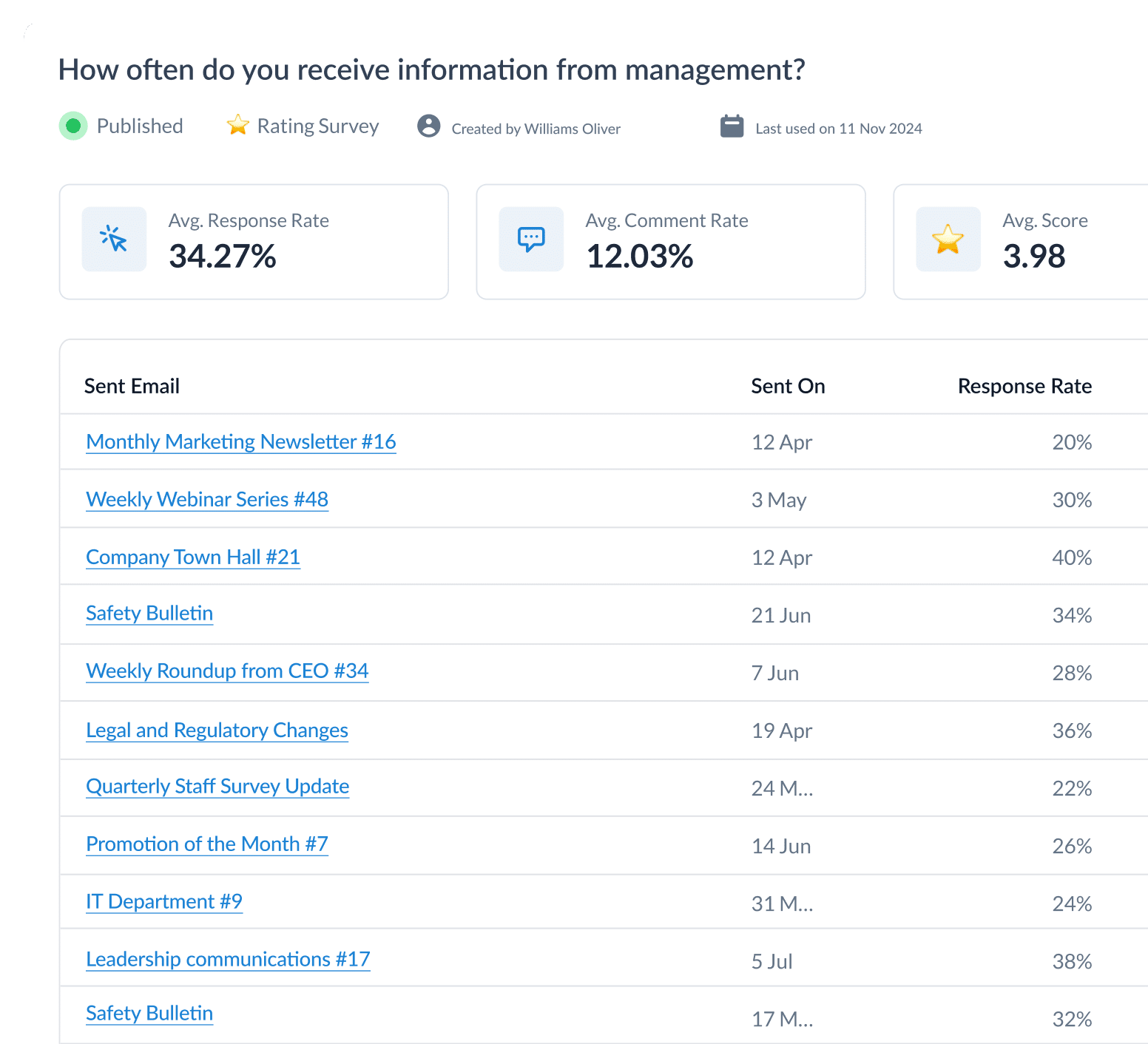
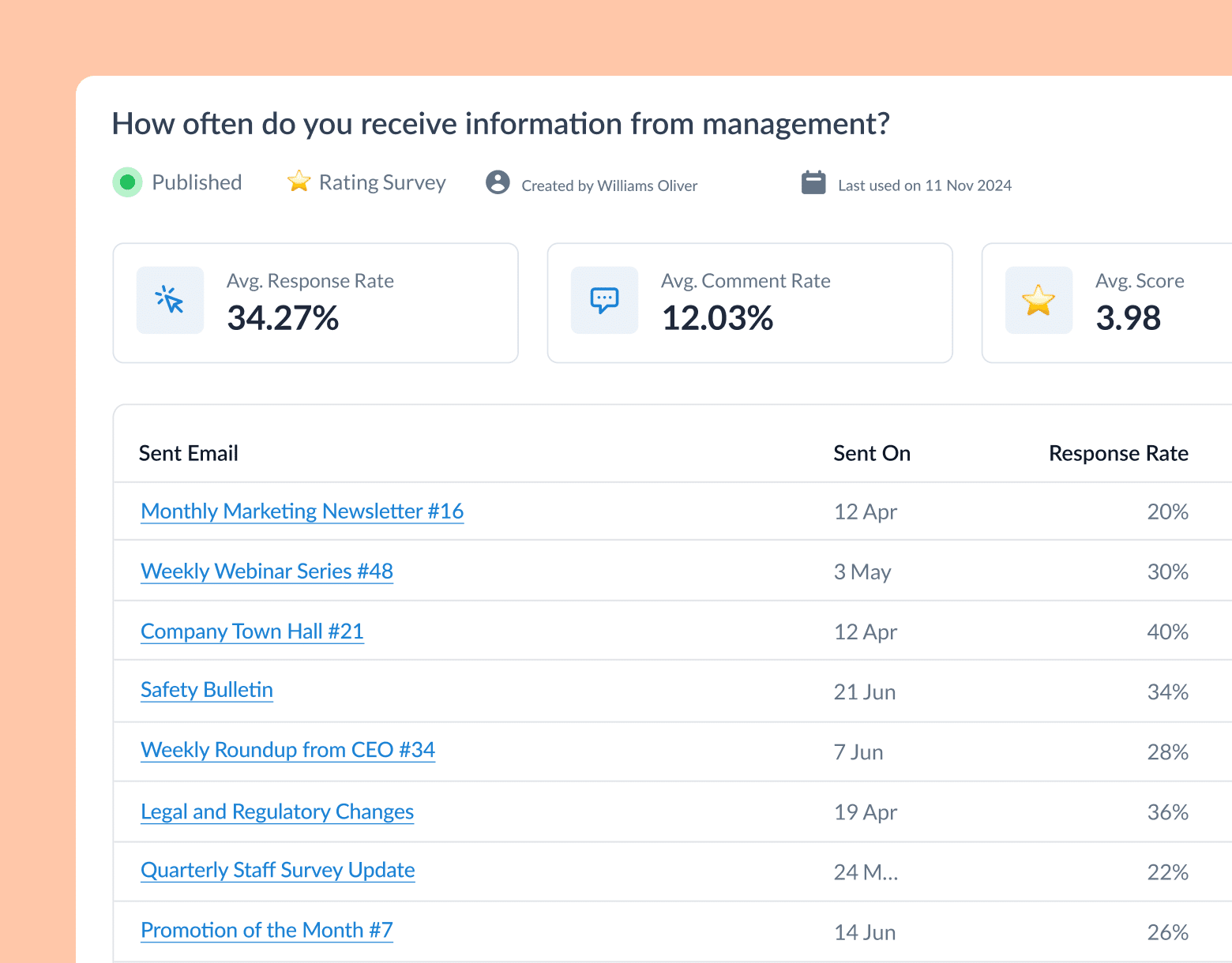
With ContactMonkey, you can create, send, and track employee opinion surveys in half the time it takes to conduct traditional questionnaires. Simply choose your preferred survey style from the drag and drop email template builder and easily add any survey into your employee emails before sending them from Outlook or Gmail:
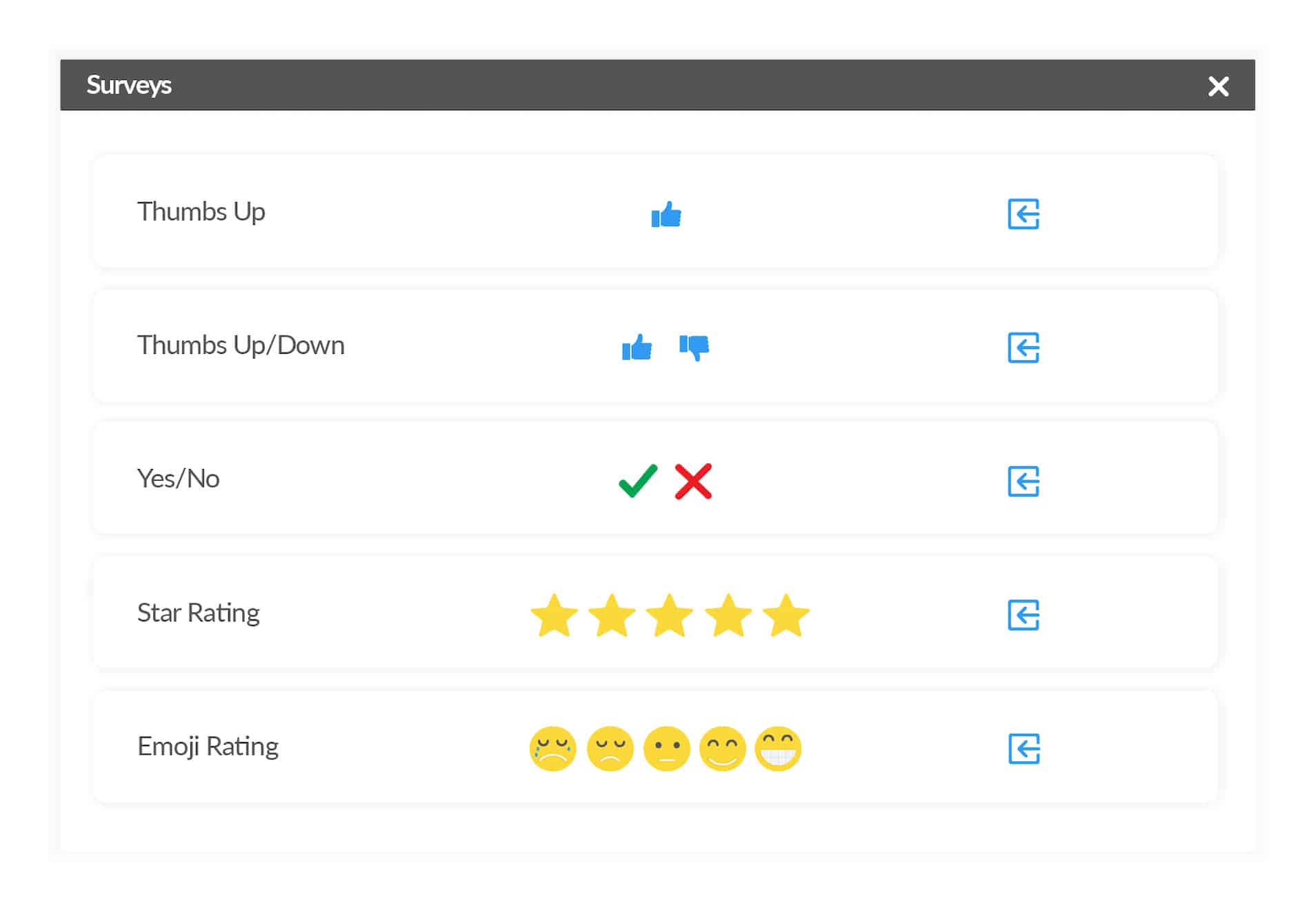
You’ll also have the option to export your survey analytics as a PowerPoint or PDF to easily present them to your teams. If you’re not sure what questions to include in your survey, try using our OpenAI ChatGPT integration to generate questions. Simply describe what you want your survey to accomplish and edit the suggested questions for your employees.
20 Employee Opinion Survey Questions to Ask Your Employees
Employee opinion surveys are as valuable as the questions you ask. In other words: it’s important to ask meaningful questions in engaging formats. Below, we’ve broken down the essential categories you need to touch upon and the best questions to use in your own employee survey templates.
Management and leadership questions
Whether it’s a department manager or company CEO, organizational leaders have a huge impact on digital employee experience. In fact, many employees who choose to leave aren’t necessarily looking to escape their company as much as they’re looking to leave bad bosses. That’s why it’s vital to conduct an employee opinion survey on leadership:
1. Does your manager recognize your work often? [Yes/No]
2. How much do you agree with this statement: “My manager provides clear goals for our group.” [Rate using numeric scale or star ratings]
3. Does your manager allows you the freedom to do your job as you feel best? [Yes/Somewhat/No]
4. My manager has the necessary technical ability to lead our group. [Yes/No]
Workload and employee wellness questions
When employees are overwhelmed at their job, they eventually check out—whether that means leaving the organization or disengaging in their roles.To avoid either of these outcomes, it’s important to be attentive to employees’ workload, overall wellbeing, and the infrastructure in place to ensure employee wellness. Ask these employee wellness survey questions:
5. Do you ever feel that stress from work is affecting your personal life? [Yes/No]
6. Can you rate your work-life balance? [Star rating]
7. Would you say your workload is manageable? [Yes/No]
8. Would an employee wellness program make a positive impact on your employee experience? If so, which kind (e.g., free fitness classes, guided Yoga, healthy snack options, meditation sessions)? [Anonymous comment box]
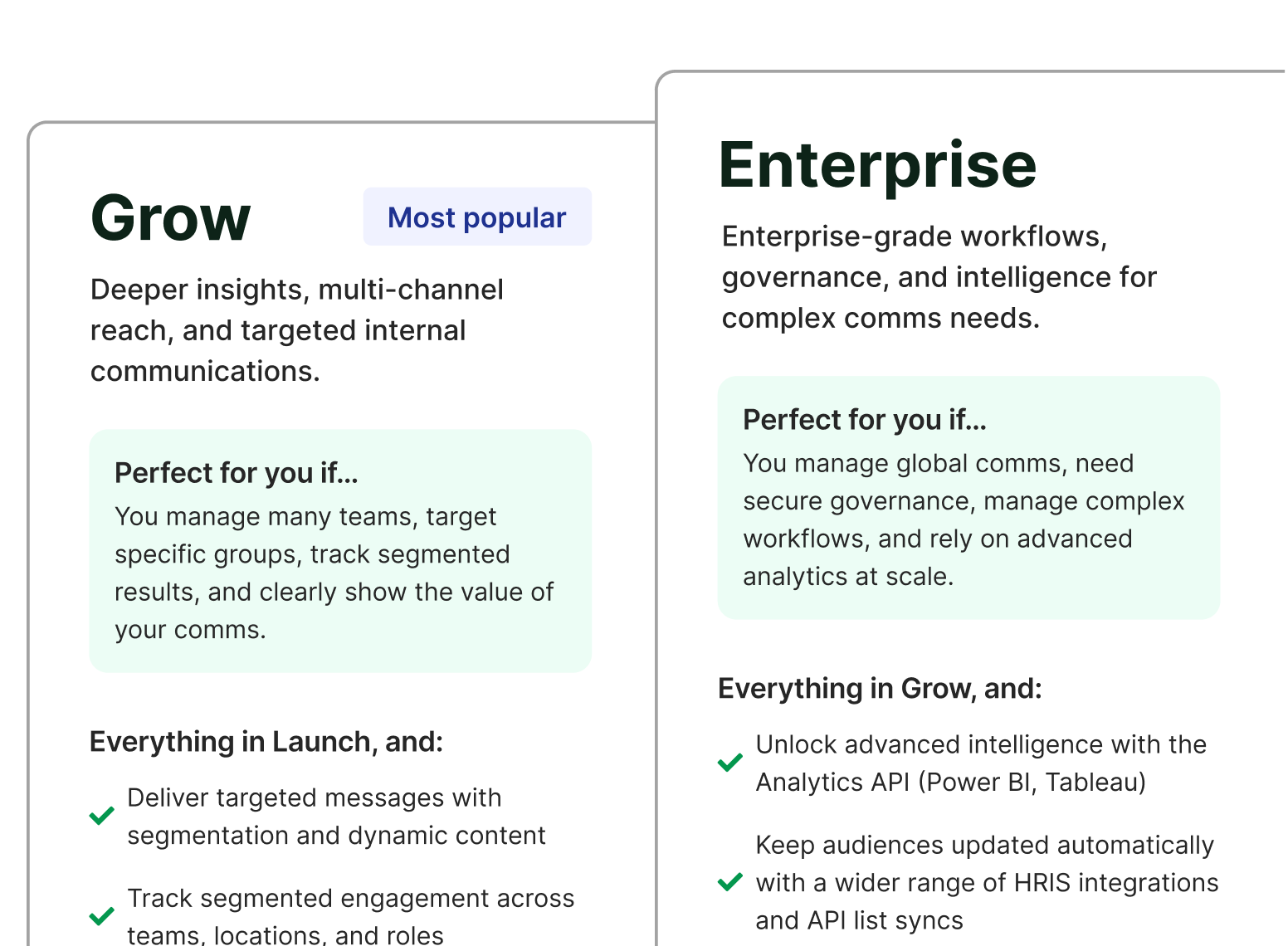
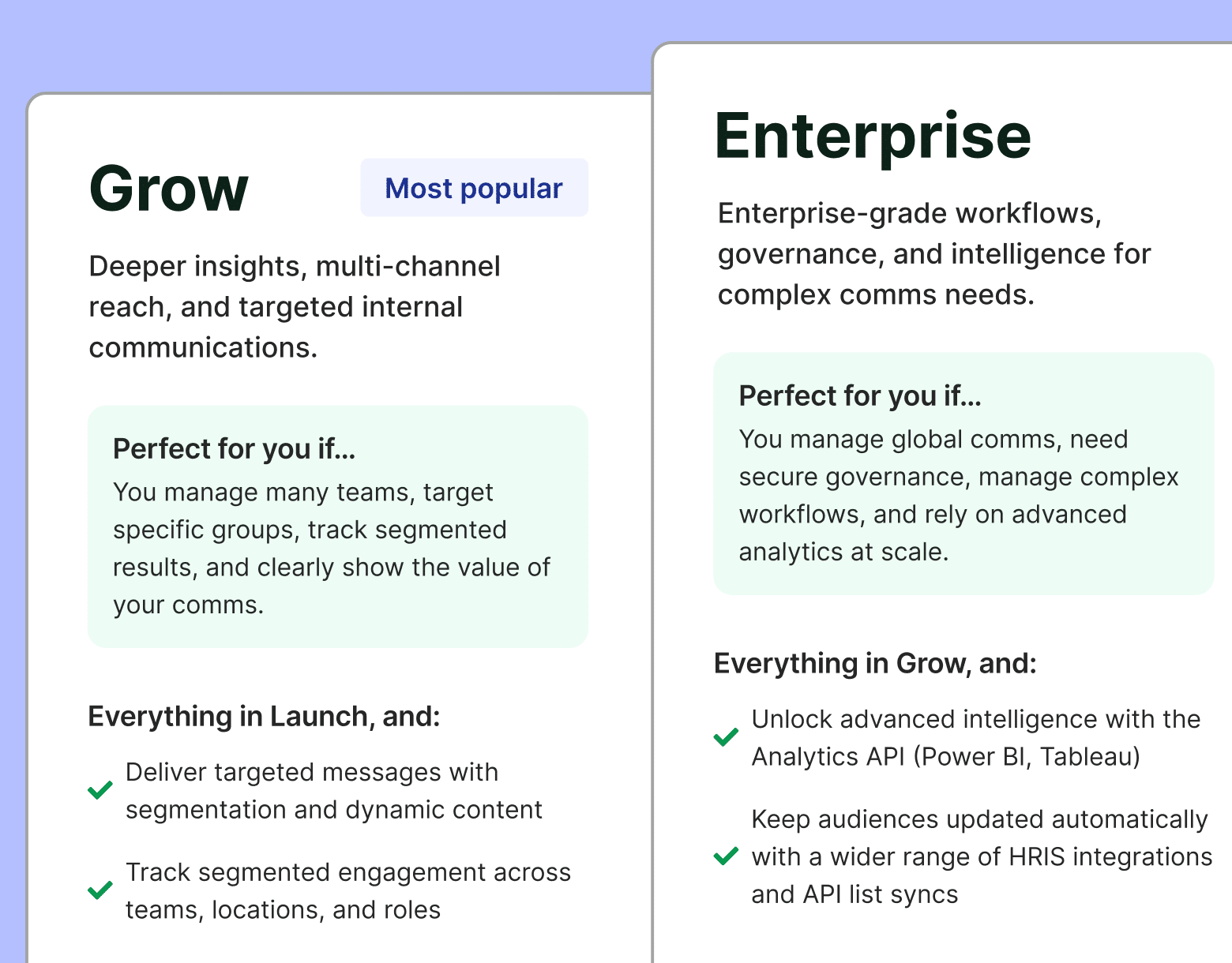
Professional development questions
Professional development is essential for employee retention. Whether it’s having additional training opportunities to expand employee skills, or promoting vertical growth within the company, professional development motivates employees to see a future in your organization. Without these opportunities, employee happiness will begin to decline, along with employee engagement:
9. Rate the importance of professional development opportunities to your overall employee experience. [Rate on a scale of 1-10]
10. Do you find the current selection of professional development opportunities at our company valuable? [Yes/No]
11. Are there any professional development opportunities we are not currently offering that you wish we had? [Yes/No answer along with anonymous suggestions box]
12. How often do the tasks assigned to you by your supervisor help you grow professionally? [Rate ‘Often,’ ‘Sometimes,’ or ‘Never’]
Compensation and benefits questions
Fair and equitable compensation and benefits are the minimum requirement for employee satisfaction at your company. No matter how many workplace perks you offer, if workers can’t make ends meet, they won’t have a great opinion of your company:
13. Would you agree that you are fairly compensated for the work you do? [Yes/No]
14. Are your benefits and compensation sufficient to support yourself and your dependents? [Yes/No]
15. Do you feel that you have a good understanding of the company’s compensation and benefits policies? [Thumbs up/Thumbs down]
16. Are there any other benefits that you wish we offered? [Anonymous comments box]
Company operations and policies questions
Remember, your employees have unique insight into how things function at your company. While managers and senior leaders may see things from a bird’s eye view, employees can expose different angles of an organization’s inner workings and offer a more nuanced perspective:
17. How would you rate your understanding of the company’s mission and values? [Rate on scale of 1-10 or using star ratings]
18. Overall do you think business operations function effectively across this organization? [Thumbs up/Thumbs down]
19. Do you find any outstanding issues with the current state of business operations? If so, what are they? [Yes/No and anonymous comments box]
20. What do you think can be done to improve business performance across the company? [Anonymous comments box]
Get powerful email analytics and reporting features
Know exactly who is opening and engaging with your employee communications and company newsletters.
Explore analytics & reporting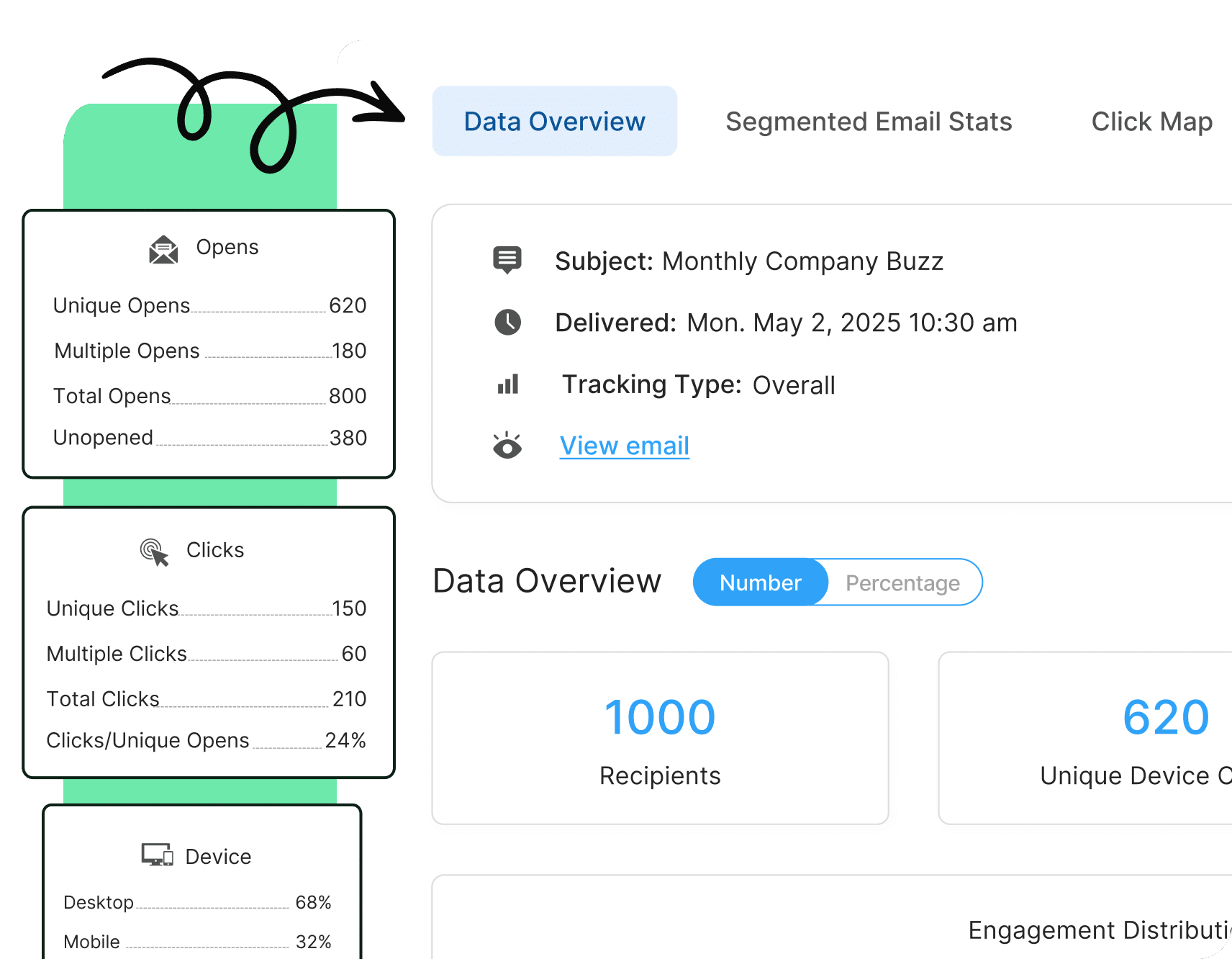
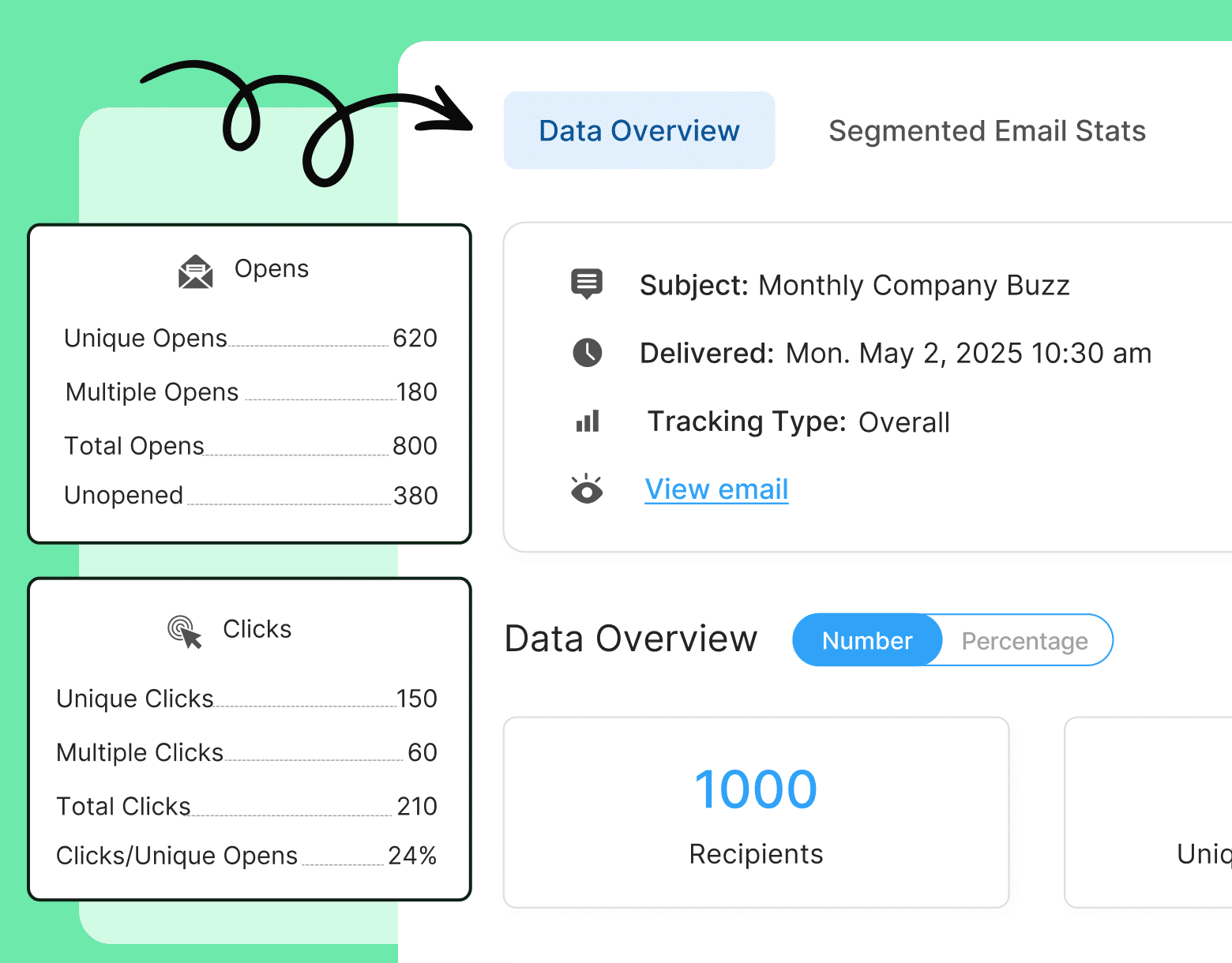
What Can You Measure With an Employee Opinion Survey?
Employee opinion surveys measure the extent to which employees are satisfied with various aspects of the employee experience.
Through a combination of quantitative responses alongside written feedback from staff, you have numerous ways to measure employee engagement.
Using these you can get a better idea of your overall employee wellness and inform your employee engagement activities.
In addition, employers can collect suggestions and get direct input from staff on how to make improvements. Here are just a few elements of your employee experience strategy that you can measure with your employee opinion survey results:
- Whether employee morale is high or low
- The level of employee participation in the company
- Employee satisfaction with health benefits, compensation, and company culture
- What employees think of the level of work-life balance in your company
- Whether employees are satisfied with the range of professional development opportunities available
Step up two-way communication across your company with our employee feedback examples.
Best Practices for Gathering Quality Employee Feedback
Now that you’ve got an idea of which questions to ask, it’s important to find an effective way to maximize your employee opinion survey response rates. This way, you can make more informed decisions when it comes to getting buy-in from senior leaders to make improvements.
Here are some tips to optimize your surveys and gather quality feedback to kick off your employee opinion survey action plan.
Guarantee anonymity: if your goal is to get honest feedback, employees need to know that their input will be entirely confidential. With ContactMonkey’s pulse survey tool, feedback is always 100% anonymous, giving employees the reassurance they need to offer authentic insights.
Make surveys short and sweet: the longer your survey, the more likely you are to lose your respondents’ attention. If you want to gather quality feedback without losing respondents in the process, it’s important to keep things clear and concise. That means staying away from buzzwords and corporate jargon, ensuring surveys take no more than nine minutes to complete, and making response options simple. With ContactMonkey, your staff can respond to surveys in seconds—straight from their employee newsletter.
Use a dedicated employee survey tool: A employee feedback tool that surveys your employees and break down the results makes your job easier. With ContactMonkey, you can embed your employee surveys into company newsletters in seconds, making feedback simple and straightforward for your employees. Not to mention, survey responses are easier to read, analyze, and present to your teams using ContactMonkey’s analytics dashboard.
Target relevant employees: Not every survey is meant for your entire organization. If you need to reach only a portion of your employees, use a custom email list. This will increase email survey engagement and reduce clutter in your employees’ inboxes. Use ContactMonkey’s List Management feature to create your own custom email lists—without needing IT—that integrate with your Human Resource Information System (HRIS) like Workday and ADP, as well as Azure Active Directory, so they’ll update automatically.
Create and Send an Employee Opinion Surveys Using ContactMonkey
An employee opinion survey can give you valuable insights to make meaningful changes for the benefit of your company. But in order to get actionable employee engagement statistics and data, you need to ask the right questions through the right medium.
Using the ContactMonkey dashboard, you can easily access, export, and present your employee opinion survey results. And make it that much easier to get buy-in from company leaders and propel meaningful change.

